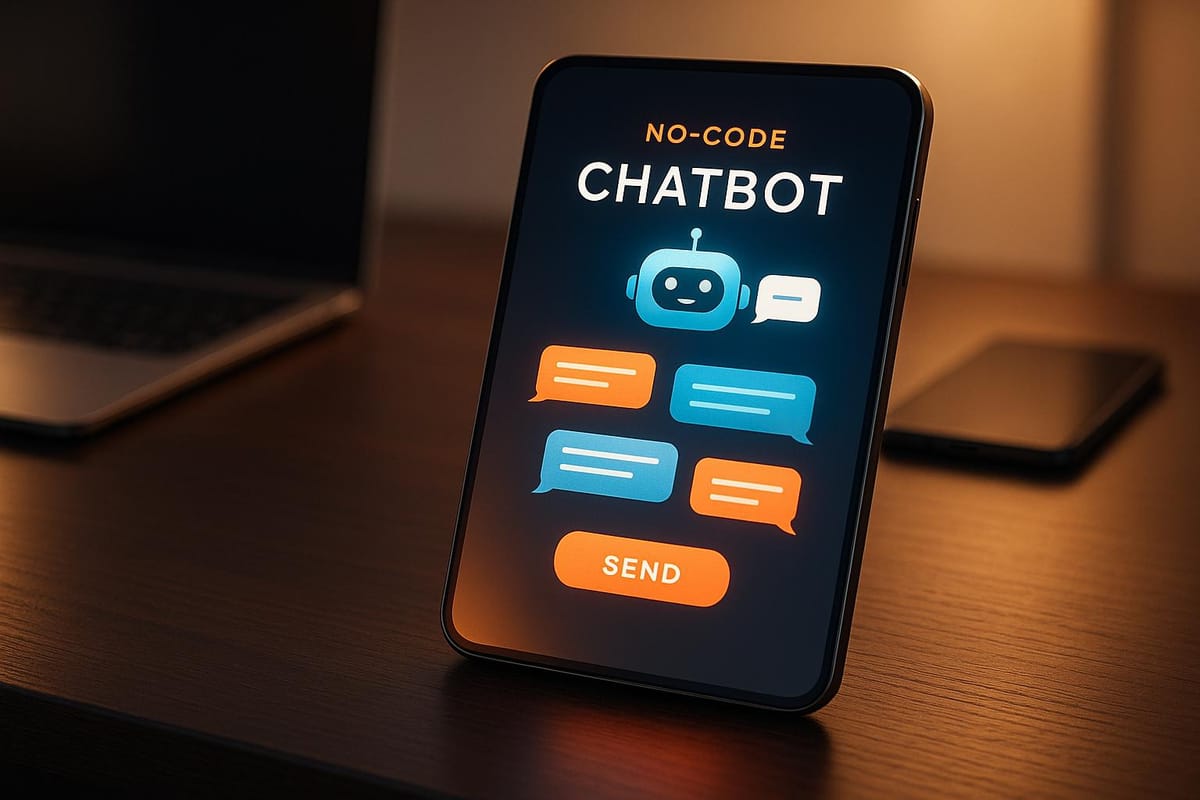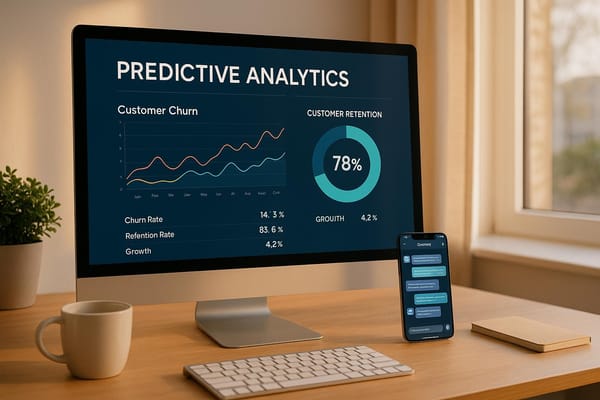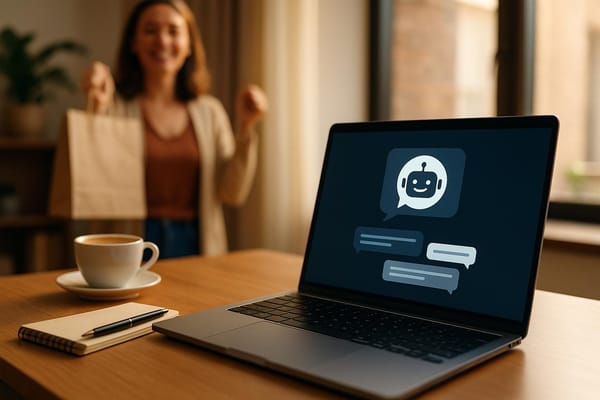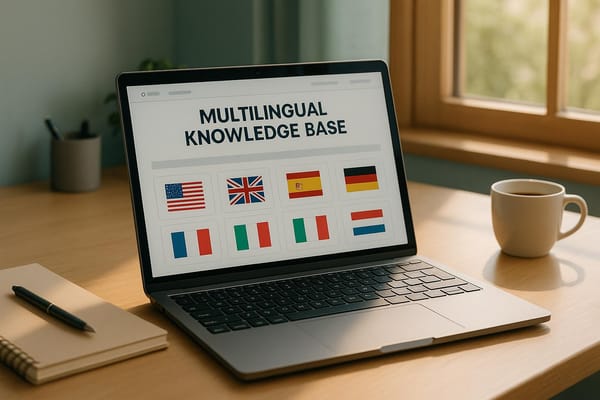Top 7 No-Code Chatbot Trends 2025
Explore the top no-code chatbot trends of 2025, from AI-driven personalization to voice commands, enhancing customer support for all businesses.

No-code chatbots in 2025 are transforming customer support by enabling businesses to create advanced, AI-driven chatbots without coding skills. These tools are affordable, starting at $49/month, and offer features like personalization, voice commands, cross-platform support, emotion detection, industry-specific templates, AI-generated responses, and process automation. Here’s a quick look at the key trends:
- Smart Personalization: Chatbots analyze user behavior to deliver tailored, context-aware responses.
- Voice Commands: Hands-free interaction through speech recognition.
- Cross-Platform Support: Seamless integration across websites, social media, messaging apps, and voice assistants.
- Emotion Detection: Recognizes customer emotions to adjust tone or escalate issues.
- Industry-Specific Templates: Pre-designed frameworks for faster deployment.
- AI-Generated Responses: Dynamic, accurate replies based on deep data analysis.
- Process Automation: Automates tasks like ticket creation, scheduling, and real-time analytics.
These trends make AI-powered chatbots more accessible, efficient, and effective for businesses of all sizes.
1. Smart Personalization with AI
AI is transforming chatbots from simple Q&A tools into dynamic conversation partners. By 2025, chatbots use advanced AI to deliver personalized interactions, analyzing user behavior and context in real time.
Modern chatbots take personalization to the next level by automatically gathering user data - like location and browser details - to create detailed customer profiles. This allows them to craft responses that align with individual preferences and past interactions, making conversations more relevant. At HelpJam, we use these advancements in our AI Chatbot to ensure every interaction meets the specific needs of our users.
But personalization doesn’t stop at basic user recognition. Businesses can fine-tune their chatbots for specific support needs by adjusting key parameters:
| Personalization Parameter | Purpose | Impact |
|---|---|---|
| GPT Version Selection | Controls AI sophistication | Matches response complexity to user needs |
| Temperature Settings | Adjusts response creativity | Balances accuracy and variety |
| Custom Prompts | Defines conversation tone | Keeps messaging consistent with brand voice |
| Rate Limits | Manages interaction frequency | Maintains smooth performance |
One of the most exciting developments in 2025 is how chatbots improve over time. They now analyze conversations, summarize interactions, and extract useful insights automatically. This ongoing learning enhances future responses, making personalization even better without requiring manual updates.
2. Voice Commands and Speech Recognition
Speech recognition technology allows no-code chatbots to handle voice commands naturally, providing a hands-free and easy-to-use support option. This is particularly helpful for users who may find typing difficult or prefer an alternative to traditional interfaces.
HelpJam takes advantage of this technology by integrating advanced voice recognition into its AI Chatbot. The system converts spoken commands into text while maintaining the flow of conversation, ensuring accurate and consistent responses.
3. Cross-Platform Support
Cross-platform functionality is shaping the way no-code chatbots operate in 2025. According to a 2024 Statista report, 78% of U.S. consumers now prefer messaging apps for customer service, making it crucial for businesses to provide seamless support across multiple channels.
Modern no-code chatbots now work across websites, social media platforms like Facebook Messenger and Instagram, messaging apps such as WhatsApp and Apple Business Chat, SMS, and even voice assistants like Amazon Alexa and Google Home. These advancements build on improvements in personalization and voice recognition technology.
A 2025 Gartner study reveals that 65% of no-code platforms now use AI to adapt responses based on the unique requirements of each channel. For example, HelpJam's unified platform ensures brand consistency with its customizable chatbox, whether on web or mobile. Their analytics show that live chat resolves customer inquiries 30% faster than social media interactions in the U.S.
Sephora's expansion of its chatbot capabilities in 2024 highlights the potential of multi-channel support. By adding Instagram Direct Messages to its existing web interface, the retailer saw a 40% increase in customer engagement. HelpJam further enhances user experience with geo-targeted settings, such as disabling SMS notifications after 9:00 PM to align with U.S. communication norms. This is particularly important, as 82% of American consumers expect responses within 5 minutes, no matter the platform.
Looking ahead, Forrester predicts that by 2026, 70% of chatbots will integrate IoT technology, connecting chat, voice, and smart home devices for a more unified customer experience.
4. Emotion Detection in Conversations
In 2025, emotion detection takes no-code chatbots to the next level, allowing them to recognize and respond to human emotions like frustration, anxiety, or satisfaction. These chatbots analyze sentiment cues and adjust their tone or escalate issues to a human agent when necessary.
For example, HelpJam's AI-powered chatbot uses advanced sentiment analysis to handle complex situations with empathy, creating a more tailored support experience.
This technology goes beyond basic sentiment analysis by enabling chatbots to:
- Recognize urgency in critical situations
- Measure the intensity of emotions being expressed
- Account for cultural and situational differences
5. Industry-Specific Chat Templates
Industry-specific chatbot templates are transforming how businesses handle customer interactions. These pre-designed frameworks cater to the unique needs of various sectors, making chatbot deployment faster and more effective. By 2025, the shift toward these tailored solutions is expected to streamline implementation while addressing specific industry demands and customer behavior patterns.
Modern no-code platforms now provide ready-made conversation flows customized for particular industries. These templates come with pre-set knowledge bases and integrations designed to match industry-specific language, compliance requirements, and common customer questions.
For instance, HelpJam's platform enables businesses to create personalized chatbots directly from a sitemap link. Users can then adjust conversation flows to fit their industry needs.
Here are some standout customization features:
- Sector-Specific GPT Models: Select AI models fine-tuned for your industry.
- Custom Prompts: Incorporate terminology and nuances relevant to your field.
- Response Style Controls: Adjust chatbot tone and response style to align with business expectations.
These settings, combined with multi-source training, ensure the chatbot learns from diverse and relevant data sources, such as:
- Knowledge base articles
- PDF documents
- Website content
- Custom data inputs
To get the most out of these templates, consider the following:
- Tailor Data Collection: Design forms to capture information specific to your sector.
- Align with Brand Identity: Customize the chatbox’s appearance to reflect your branding and connect your domain for seamless integration.
- Fine-Tune Responses: Adjust prompts and response settings to maintain professionalism and meet industry-specific response time expectations.
These templates strike a balance between ease of use and customization, paving the way for chatbots that are both industry-aware and easy to deploy. This trend highlights the growing demand for more specialized and effective chatbot solutions tailored to unique business needs.
6. AI-Generated Response Content
AI-generated responses are taking chatbot communication to a new level, offering precise and engaging interactions. By 2025, advanced algorithms are shaping chatbots to deliver personalized, context-aware replies based on deep data analysis.
Modern AI systems pull information from various sources to craft informed and accurate responses. For example, HelpJam's platform allows businesses to train their AI chatbots using their sitemap file. This approach automatically indexes and processes website content, enabling chatbots to provide well-informed answers.
What’s New in AI Response Generation?
AI-generated content now offers capabilities like:
- Summarizing complex conversations automatically
- Crafting replies that consider the context of the interaction
- Enhancing response quality for clarity and relevance
- Adjusting message length to suit user preferences
- Learning from real-time interactions to improve responses
To make the most of these advancements, focus on three key areas:
- Response Customization: Tailor GPT models and prompts to align with your brand’s tone and industry needs.
- Quality Control: Use tools like temperature settings and rate limits to ensure consistent response quality.
- Continuous Learning: Keep the AI updated with new information to maintain accuracy and relevance.
Breaking Down Key Components
Here’s how these improvements translate into better chatbot performance:
| Component | Purpose | Impact |
|---|---|---|
| Data Integration | Combines multiple information sources | Delivers more complete answers |
| Context Analysis | Tracks and understands conversation flow | Ensures more relevant replies |
| Response Optimization | Adjusts quality and length of content | Enhances user experience |
| Continuous Training | Updates AI knowledge base | Improves accuracy over time |
These advancements strengthen the support experience by making transitions between AI and human agents smoother, reducing the workload for support teams. Regular analysis of conversation data further sharpens response precision and overall effectiveness.
The rise of AI-generated responses marks a major evolution in customer support automation. It allows businesses to maintain high-quality, scalable conversations while easing the pressure on human teams.
7. Process Automation Features
Process automation has become a game changer in no-code chatbot development, reshaping how businesses handle repetitive tasks and customer interactions. Here's how workflow integration plays a major role in these advancements.
Advanced Workflow Integration
Today's no-code chatbots can effortlessly connect with various business tools, making it possible to automate tasks across different platforms. For example, chatbots can:
- Automatically create support tickets
- Update customer records in real-time
- Schedule appointments
- Handle refund requests
- Generate detailed reports
Data-Driven Automation
Automation features now use multiple data sources to streamline operations and improve performance:
| Data Source | Benefit | Result |
|---|---|---|
| Knowledge Base | Access to verified solutions | Faster and more accurate responses |
| Website Content | Automated indexing | Enhanced information accuracy |
| Customer Interactions | Pattern recognition | Anticipating customer needs |
| Support Documentation | Generating consistent responses | Better service quality |
Smart Task Distribution
In addition to automating tasks, chatbots now handle task distribution more effectively. When a query is too complex for the bot, it can:
- Direct the conversation to the right team member
- Share relevant context from past interactions
- Monitor the resolution process
These features ensure customers receive accurate and timely support without slowing down operations.
Real-Time Analytics Integration
Modern chatbots gather and analyze interaction data on the spot, providing actionable insights to improve workflows. These analytics can highlight:
- Peak times for support requests
- Common customer challenges
- Gaps in chatbot responses
- Areas where processes can be refined
Chatbot Technology Comparison
No-code chatbots have come a long way, with key differences now evident between rule-based systems and AI-driven platforms. Here's a breakdown of how AI advancements are reshaping chatbot performance compared to traditional models.
Core Capabilities
| Feature | Rule-Based Chatbots | AI-Powered No-Code Chatbots |
|---|---|---|
| Response Generation | Predefined scripts | Dynamic, context-aware replies |
| Learning Ability | Manual updates required | Learns from user interactions |
| Knowledge Integration | Limited to specific content | Accesses multiple content sources |
| Conversation Flow | Fixed, linear paths | Flexible and adaptive discussions |
| Maintenance | Frequent updates needed | Self-updating system |
Intelligence and Flexibility
AI chatbots go beyond static, pre-programmed interactions. They understand queries in real time and adapt conversations naturally. Customization options like GPT version selection, prompt engineering, and temperature tuning allow businesses to align chatbot behavior with their needs.
Training and Knowledge Management
Modern AI chatbots streamline training by pulling data from diverse sources like knowledge bases, PDFs, websites, and past conversations. This eliminates the need for constant manual updates. These systems also keep their knowledge up-to-date automatically, ensuring responses remain accurate and relevant.
Response Quality
AI-powered chatbots excel at producing replies that are not only contextually accurate but also polished and concise. They analyze conversations to improve over time, ensuring responses meet user expectations.
Human Support Integration
When faced with complex queries, AI chatbots can seamlessly hand off conversations to human agents. This ensures that customer issues are resolved effectively, no matter their complexity.
Real-Time Analytics and Optimization
AI systems take performance a step further with real-time analytics, identifying trends and refining responses based on successful interaction patterns. This continuous feedback loop helps improve customer engagement and satisfaction.
For example, platforms like HelpJam combine AI-powered chatbots with live chat functionality, showing how automation and human support can work together to improve customer service and simplify operations.
Conclusion
The no-code chatbot market is evolving alongside advancements in AI, transforming the way businesses handle customer support. These changes are enabling smarter, more personalized interactions that redefine automation.
For example, GreenGadgets reported a 40% drop in support tickets and a 25% boost in customer satisfaction after implementing HelpJam's AI Chatbot in Q3 2024. This case highlights how modern tools can deliver measurable improvements through intelligent automation.
AI advancements combined with no-code tools have made sophisticated chatbot technology available to businesses of all sizes. HelpJam stands out by offering features that improve efficiency and customer engagement, showing how accessible technology can create meaningful results.
What’s next? Features like emotion detection and voice commands are on the horizon, promising even better customer experiences. These developments are especially valuable for small and medium-sized businesses aiming to scale their support operations effectively. Platforms like HelpJam are leading the charge in reshaping customer service.
"Deliver exceptional customer support using our AI Platform" - HelpJam
AI-driven customer support is no longer a concept - it’s here.
: GreenGadgets Internal Report, October 2024
FAQs
How will no-code chatbots deliver personalized user interactions in 2025?
No-code chatbots in 2025 will leverage advanced AI and machine learning to provide highly personalized interactions. By analyzing user behavior, preferences, and past interactions, these chatbots can tailor responses to meet individual needs seamlessly.
Additionally, integrations with CRM systems and other tools will allow chatbots to access detailed customer data, ensuring interactions feel more human and relevant. These advancements make it easier for businesses to enhance customer engagement while maintaining efficiency.
What are the benefits of adding voice command capabilities to no-code chatbots for customer support?
Integrating voice command capabilities into no-code chatbots can significantly enhance the customer support experience. Voice commands make interactions faster and more convenient, allowing users to communicate naturally without typing. This can be especially helpful for accessibility, as it ensures inclusivity for users with disabilities or those on the go.
Additionally, voice-enabled chatbots can create a more personalized and human-like experience, fostering stronger customer engagement. They also streamline tasks like placing orders, resolving issues, or accessing account information, improving overall efficiency and satisfaction for both customers and support teams.
What are the advantages of using industry-specific chatbot templates for businesses?
Industry-specific chatbot templates can help businesses streamline their customer interactions by offering pre-designed solutions tailored to their unique needs. These templates are built with sector-specific workflows, terminology, and user expectations in mind, reducing the time and effort required for setup.
By leveraging these templates, businesses can provide faster and more accurate responses, improve customer satisfaction, and enhance operational efficiency. For example, a healthcare chatbot template might include appointment scheduling and medication reminders, while an e-commerce template could handle product recommendations and order tracking seamlessly. This customization ensures businesses can deliver a more personalized and effective customer experience.





